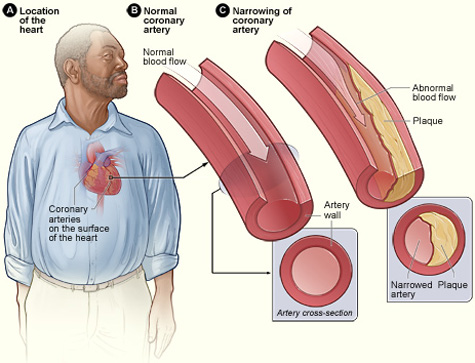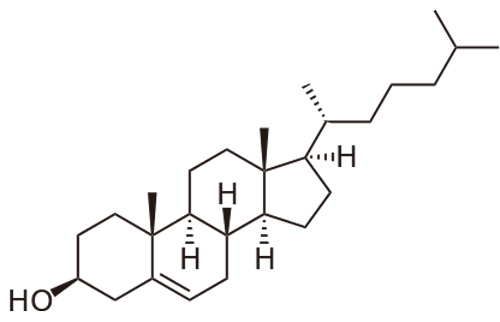
Peter Attia
Few things in nutrition and public health are as controversial as cholesterol and heart disease risk, as well as how the two are affected by diet.There is an immense amount of research on this topic, but a lot of it is tainted by bias and commercial influences.
Additionally, a large percentage of health professionals seem to be basing their recommendations on knowledge that became outdated many years ago.
In the
video above, Dr. Peter Attia, a medical doctor and one of the founders of the Nutrition Science Initiative (
NuSi), explains everything you need to know about diet, cholesterol and lipoproteins.If you're a nutrition enthusiast (likely if you're reading this), then I
highly recommend that you watch this video, even more than once.This video explains better than
anything I've ever seen how all of these things are related to diet and how they affect our risk of heart disease.
All of this is a
critical piece of the puzzle if you want to understand the complex interactions between fat,
carbs, diet and health.
Atherosclerosis is what drives heart diseaseWhen discussing heart disease, it's important to realize exactly what that means.The
heart is a muscle that generates the force that propels blood throughout our vascular system.
The heart requires a constant supply of oxygen and fuel and has its own private blood supply... the
coronary arteries, which circulate around the heart.
Atherosclerosis is the technical term for what drives heart disease. It involves cholesterol-filled structures called "plaques" building up inside the artery wall.This plaque gets larger and larger over time, filling up with cholesterol, inflammatory cells and all sorts of tissue damage.

© NIH
Eventually, when this process has progressed for decades, this plaque can rupture. When this happens, the blood in the artery clots.This
blood clot can clog the coronary artery and block the flow of blood, either partially or completely, which deprives the heart of oxygen.Unless the clot is dissolved or removed very quickly (such as via emergency surgery), a part of the heart muscle will die, never to recover completely. This is what is called a
heart attack, and if severe enough, can cause death.
This disease is actually the world's most common cause of death, and has been so for the past century (
1). For this reason, the importance of understanding how to prevent it can not be overstated.
A
key step in the heart disease process is a sterol (mainly cholesterol) finding its way inside the arterial wall, then being eaten by a cell called a
macrophage.Macrophages are cells that "eat" other molecules, bacteria and even other cells. They are part of the immune system and are found everywhere in the body.
When cholesterol gets past the arterial wall and gets eaten by a macrophage, an inflammatory reaction begins, which further exacerbates the condition and can lead to a vicious cycle.
Heart disease is actually a very complicated process and involves various other factors... including inflammation and oxidative stress.
But the most important point in this discussion, is that without cholesterol getting past the arterial wall and being eaten by a macrophage, heart disease
will not happen.
Cholesterol is absolutely essential for humansCholesterol is an organic molecule that humans can not live without.
This is what it looks like:

© Wikipedia
It is found in the membrane of every single cell in the body, helping to regulate fluidity and structure.Cholesterol is also used to make
steroid hormones like testosterone, cortisol, estrogens and the active form of Vitamin D.
The truth is, cholesterol is so important that the body has evolved many incredibly complex mechanisms to ensure that we
always have enough.Most of the cholesterol in our bodies is actually produced by our own cells and every cell in the body can produce cholesterol. The cholesterol we eat is usually a minor source compared to the amount we produce.
Without cholesterol, humans (and other animals) would not exist. Plain and simple.
What people call "cholesterol" isn't really cholesterol, it's the proteins that carry cholesterol aroundWhen people talk about "cholesterol" in regards to heart health, they usually aren't talking about cholesterol itself.Instead, they are referring to the structures that carry cholesterol around, called
lipoproteins.
Because cholesterol is fat soluble, it can not travel through the bloodstream on its own. It's like an oil droplet in a glass of water, it simply won't mix.For this reason, cholesterol is carried around the bloodstream in lipoproteins, which function as carrier vehicles.
Lipoproteins also carry other molecules, such as triglycerides (fats), phospholipids and fat-soluble vitamins.Lipoproteins are basically a core full of fat and cholesterol, along with a lipid membrane that contains proteins called
apolipoproteins.
There are many types of lipoproteins, but the two most important ones are called
LDL (Low Density Lipoprotein) and
HDL (High Density Lipoprotein).
These are commonly referred to as the "bad" and "good" cholesterol, but this is actually inaccurate.
All cholesterol is the same, it's the lipoproteins that are different.What doctors routinely measure, Total cholesterol, LDL-c and HDL-c, refers to the amount of cholesterol carried within different types of lipoproteins.
Having a high "Total" cholesterol means that you have a lot of "cholesterol" in your blood, but it doesn't say anything about which lipoproteins it is found in.Having high LDL means that a lot of the cholesterol in your blood is packaged in LDL lipoproteins. Having high HDL means that a lot of it is packaged in HDL lipoproteins.
"Total" cholesterol is actually a rather useless marker, because having high HDL (protective) contributes to a high total cholesterol.
So... it is critical to understand that heart disease really is NOT a cholesterol disease, it is a lipoprotein disease.Having a lot of "cholesterol" in your bloodstream is NOT a bad thing, unless this cholesterol is being carried around in the wrong lipoproteins.
It is common knowledge that having a lot of cholesterol within LDL lipoproteins is associated with heart disease, while having it carried by HDL lipoproteins is associated with reduced risk (
2,
3).This is one example of where "conventional wisdom" is right... but this is still a drastic oversimplification that often leads to the wrong conclusions being made.
To understand what lipoproteins really have to do with heart disease, then we need to start looking at more "advanced" markers like LDL particle number.
LDL cholesterol (LDL-c), LDL size and LDL particle number (LDL-p)When it comes to heart disease risk, the LDL lipoproteins are the most important.However... the picture is much more complicated than simply "LDL = bad."There are subtypes of LDL, mainly depending on the size.Their size is often classified as either "small, dense LDL" or "Large LDL" (
4,
5,
6).
Studies show that people who have mostly small particles, called Pattern B, have up to a three times greater risk than people with mostly large particles, called Pattern A (
7).
However... as Peter points out in the video, the most important marker of all is
the number of LDL particles (called LDL Particle Number, or
LDL-p).Their size, as well as the amount of cholesterol (LDL-c) they carry, becomes meaningless when you account for LDL particle number.
In order to understand how LDL-c, LDL size and LDL-p are interrelated, imagine that you are going to fill a bucket with golf balls and tennis balls.The bucket is the total amount of cholesterol contained within LDL (LDL-c). The golf balls are small LDLs, while the tennis balls are Large LDLs.The total number of balls is the LDL particle number.You can fill the bucket with either tennis balls, or golf balls. The bucket will be just as full, but if you use golf balls the
number of balls in the bucket will be much greater.
LDL "cholesterol" is the same... for a given level of LDL, having more small particles will mean that you will have a
much higher number of particles, carrying the same amount of cholesterol.
This diagram from Peter's lecture demonstrates it pretty well:
You can carry a certain amount of cholesterol in a
high number of small LDLs, or you can carry the same amount in a
low number of large LDLs.According to Peter, the main reason small LDL is bad, is because people who have mostly small LDL are more likely to have a higher total number of particles.
It's not the small size that drives heart disease, but the fact that people with small particles tend to have a higher number of particles.In other words, having a lot of small LDL is a
marker for another more important problem.
According to the Quebec heart study, which Peter talks about in the video, LDL size does not matter when LDL particle number is controlled for (
7).
A big problem when using LDL-c to determine heart disease risk, is that it is possible to have normal or lowish LDL-c, while still having high LDL-p.Although LDL-c and LDL-p are usually correlated, sometimes they are not. This is called discordance (
8).The truth is, LDL-p is what really matters here. Measuring just LDL-c can be misleading, because it is irrelevant unless LDL-p is also high.LDL-p can also be estimated by measuring another marker called
ApoB. Each LDL lipoprotein particle has one ApoB protein (Apoprotein B), so the higher the number, the higher the LDL particle number.
LDL particle number is an "advanced" risk factor that many health professionals don't know about and is rarely measured. However, it may just be the strongest and most important risk factor there is for heart disease. It has a direct role to play in the pathological process.Refined carbs and sugar (not fat) are the major drivers of elevated LDL particle numberAgain... heart disease does not happen without cholesterol finding its way beyond the artery wall.Cholesterol is the "cargo" while the lipoproteins are the "boats."The more boats you have, the greater the chances of some of these lipoproteins penetrating the arterial wall.Therefore, anything that increases the number of LDL particles in your bloodstream will increase your risk of heart disease.Interestingly,
refined carbs and sugar appear to be the primary culprits here.A study that Peter talks about showed that
fructose and HFCS drastically increased triglycerides and ApoB (a marker for LDL-p) in the blood of healthy subjects (
9).This happened within as little as 2 weeks, using amounts of sugar that are similar to people's average consumption.
Another interesting fact is that low-carb diets tend to reduce ApoB/LDL-p, indicating that even though they may mildly raise LDL-c (which usually doesn't even happen, on average), they should lead to a reduced risk of heart disease (
10,
11).
If we look at LDL-p or ApoB instead of LDL-c, then the picture of diet and heart disease risk changes dramatically.If we take these markers into account, then
heart disease is driven primarily by sugar and refined carbs, while a low-carb diet should directly reduce the risk.However... as I've
mentioned before, a subset of individuals does experience increased LDL-p on a low-carb diet, so it may not work in this way for everyone.Whether this matters in the context of improvements in other markers (blood pressure, inflammation, blood sugar, triglycerides, HDL, for example) is not known.
Where to find more infoIf you want to delve even deeper into the science behind all of this, then Peter has written a comprehensive 9-part series on his blog,
The Eating Academy.The series is called "The Straight Dope on Cholesterol":
Parts I,
II,
III,
IV,
V,
VI,
VII,
VIII,
IX.
You can read a simplified version (but still pretty thorough) on Mark's Daily Apple:
Part 1 and
Part 2.Of course, even Peter's long series is a major simplification of a highly complicated subject.
There are many other factors involved, including blood pressure, inflammation and oxidative stress, and most of these things are still being debated by scientists.
The bottom line: Cholesterol is NOT the enemyI often refer to HDL and LDL as the "good" and "bad" cholesterol in my articles.The main reason is that I try to write articles that are understandable by a lay audience, and most people are familiar with these terms.However... I may be contributing to confusion and misinformation by doing this and will consider my choice of words carefully in the future.
Looking at the current state of the evidence, it becomes very clear that "cholesterol" is NOT the enemy.Heart disease is not a cholesterol disease, it is driven by the lipoproteins that carry cholesterol around.
Maybe:
Quote: "Heart disease is not a cholesterol disease, it is driven by the lipoproteins that carry cholesterol around".
Should read:
Heart disease is not a cholesterol disease, it is driven by the trans fatty acid lipoproteins that carry cholesterol around.
[Link]
(Just one of hundreds of examples)
But we better ignore this and take the blue pill...